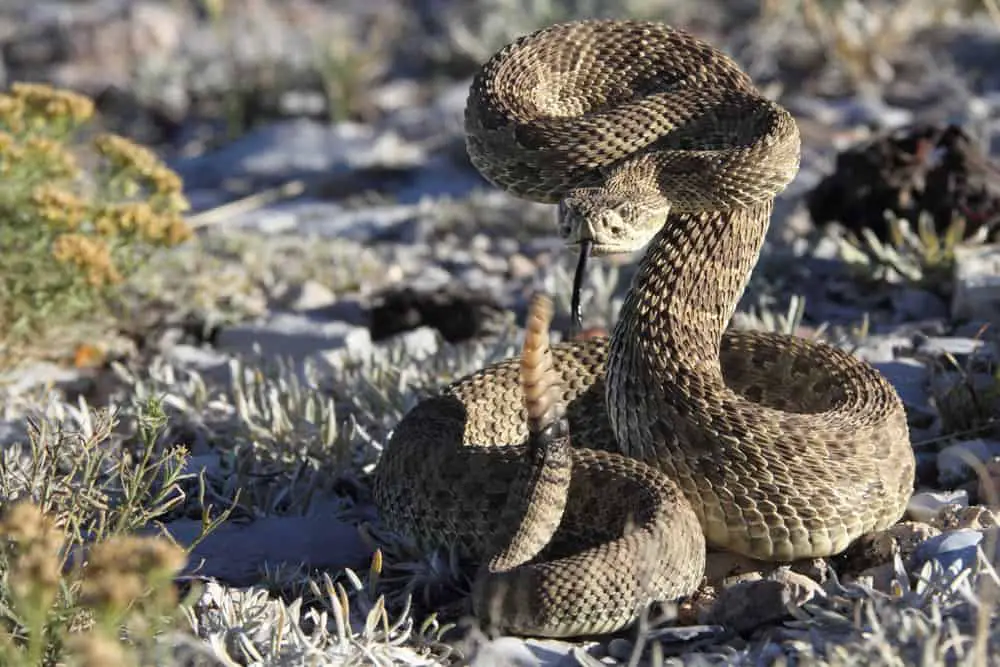
Rattlesnakes are venomous serpents recognized by their tail end rattle that produces a whirring sound when the tail is rapidly shaken; this is a threat stance to warn prey and ward off predators.
Rattlesnakes belong to the Viper family (Viperidae). The Viperidae family is divided into three subfamilies: Viperinae, Crotalinae, and Azemiopinae. The Rattlesnake species are divided into the Crotalus and Sistrurus of the subfamily of Crotalinae, commonly referred to as Pit Vipers.
All Rattlesnakes are indigenous to the Americas and range from southern Canada to Mexico and Argentina and throughout the United States (US). In the US, the most predominant snakebites are from Rattlesnakes, but they only bite if provoked.
Table of Contents
- Types of Rattlesnakes
- Conclusion
Types of Rattlesnakes
There are 36 species of rattlesnakes; there are about 60 to 75 subspecies, all Rattlesnakes are Vipers. The Viper or Viperidae genus is divided into three main divisions- Viperinae, Crotalinae, and Azemiopinae. Rattlesnakes belong to the Crotalinae family.
Crotalinae
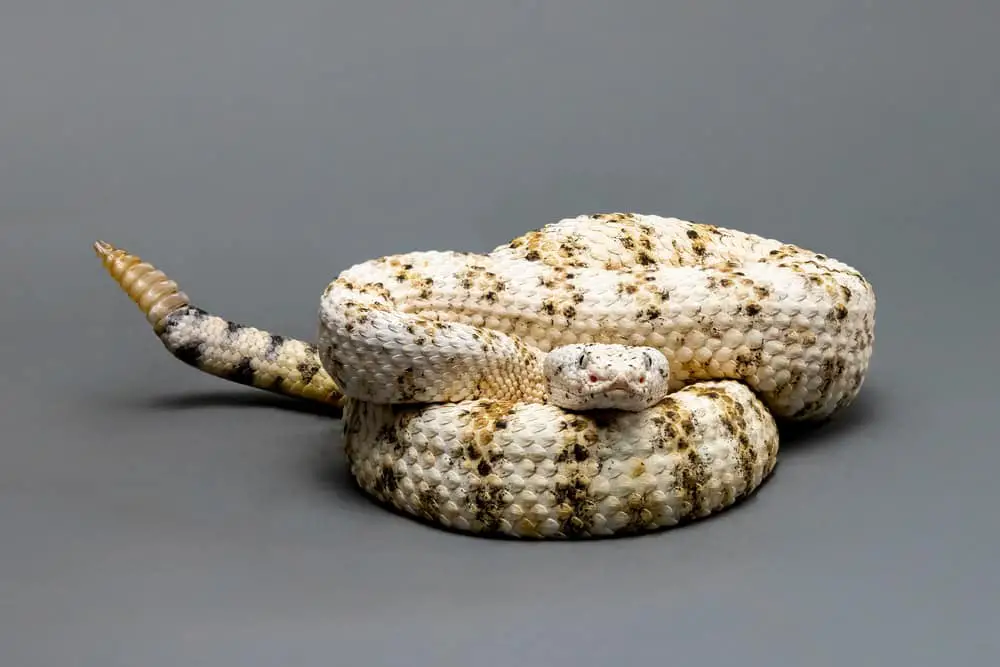
The rattlesnakes belong to the Crotalinae family, commonly referred to as Pit Vipers. They are classed according to two heat-detecting organs positioned on their face below their nostrils. These are the only genus to possess these organs, giving them a superior advantage as a predator.
These pits or sacs sense thermal radiation emitted from a warm-blooded animal. The detection range is relatively limited, at about 1 foot. Infrared light passes through tiny pin-hole openings that lead to a membrane with specialized tissues cells that warm and alert the Viperid of the presence of prey.
The membrane comprises an acute arrangement of heat-sensitive receptors that can detect changes in temperatures of 32.0054 °F or less within its range. These pits give the Viperids of the Crotalinae division a sixth sense.
Crotalinae are also characterized by their triangular head, shaped due to the developed venomous pouches located in the mouth. Their heads are distinct from their necks and covered in numerous small scales.
Among all the Viperids, the Crotalinae subspecies are the only ones to possess a specialized muscle, referred to as muscularis pterigoidus glandulae. This specified muscle is positioned between the venom gland; contraction of this muscle pushes the venom out.
There are two divisions of Rattlesnakes- Sistrurus, and Crotalus. Both have similar and distinct characteristics yet are unique from each other.
Crotalus
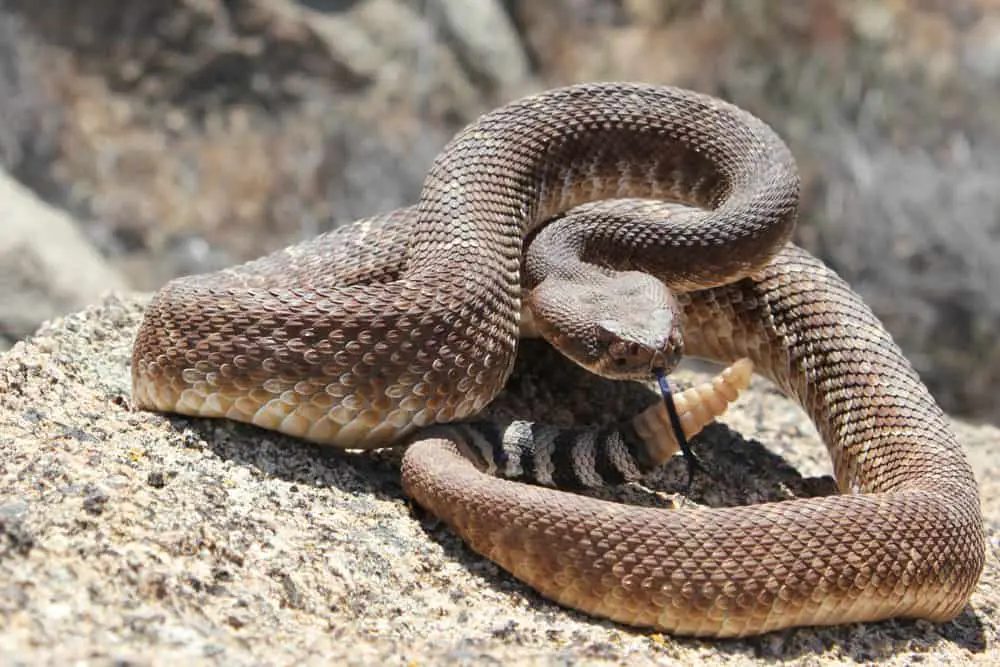
The Crotalus is a genus of the venomous Pit Viper. The name Crotalus has its etymology from Greek Krotalon, which means castanet; it references the resonant whizzing or buzz of the rattle produced by the end tail. This distinct behavioral feature allows them easy recognition.
There are currently 32 to 45 recognized species of the Crotalus. They are primarily situated in the Southwestern US and Northern Mexico. Members of the Crotalus family vary in size- from 20 to 59 inches. Typically, adult males outsize females.
The rattle is comprised of an arrangement of interlaced hollow keratin casings. Keratin is a fibrous protein like the substance of your fingernails. As the Rattlesnake grows older, the keratin segments fray off. New casings grow when the Rattlesnake sheds its skin.
Every time the skin is shed, a new button or shell is added. The cases are hollow, the resonate sound is produced from the tail end’s vigorous back and forth motion, approximately 60 times per second.
The Rattlesnake coils its body in a threat stance, and as the muscles contract, the keeled scales rub together, producing a crackling, whirling sound heightened by the vigorous shaking of the keratin shells of the rattle at the tail end.
The temperament of the Crotalus is mild, and this species isn’t characteristically aggressive. If the Rattlesnake is threatened, it quickly withdraws, but it will defend itself if accosted.
The diet of the Crotalus is a selection of vertebrates and invertebrates that includes amphibians, rodents, birds and other serpents. Instances of cannibalism do exist in some species.
Threats to the Crotalus are primarily from human beings. Natural predators include other snakes, particularly the Kingsnake, Coachwhips, Indigo snakes, and Racers.
Birds also prey on the Rattlesnake; however, it involves risks, and there are reports of the bodies of dead hawks next to snakes that have hemorrhaged and have evident gangrenous necrosis from snake bite venom.
Rattlesnake venom is a highly complex substance; it has two chief hemotoxic properties. Hemotoxins devastate red blood cells, inhibit blood clotting (anticoagulant), are responsible for tissue deterioration.
The first hemotoxin is called metalloproteases. Metalloproteinase impacts the capillary endothelial cells and creates platelet aggregation and bleeding. The endothelium is a delicate membrane that lines the inner walls of the heart and blood vessels.
Secondly, crotalin, a platelet aggravating hemotoxin, triggers intense bleeding as the toxin fastens to the surface proteins, blocking aggregation. These two contradicting actions rapidly spread through prey, immobilizing them and digesting tissue.
The venom of Rattlesnakes also contains neurotoxins; these toxins impact the circulatory and respiratory systems. The enzymes in the venom can also paralyze. The snake bite can be fatal, and immediate medical treatment is needed if bitten.
Crotalus Adamanteus (Eastern Diamondback Rattlesnakes)
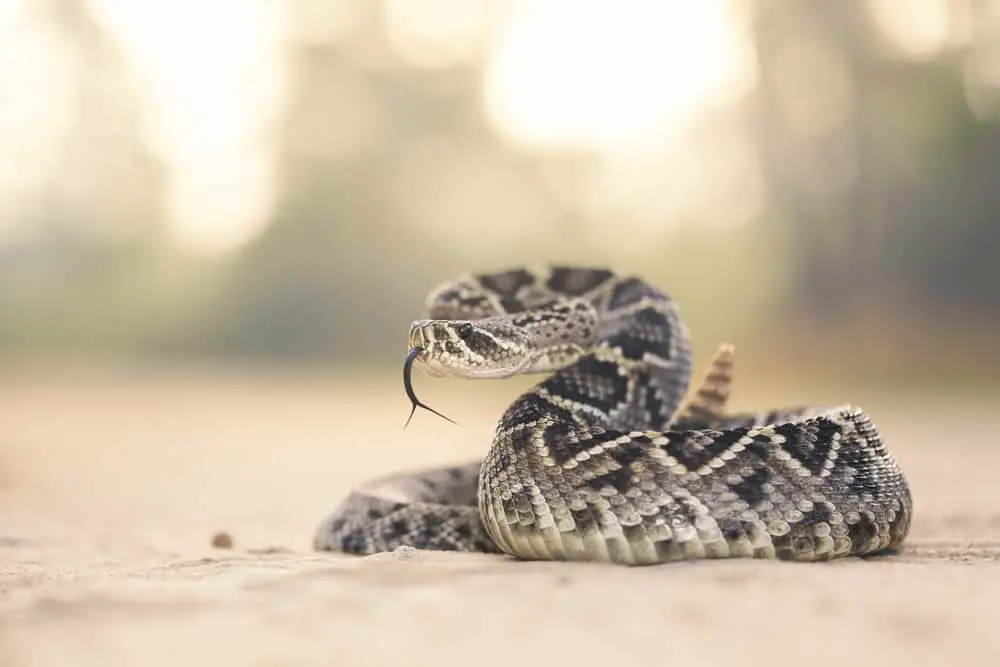
The Crotalus Adamanteus is a venomous Viper of the Crotalinae subdivision (Pit Viper) of the Viperidae family. This genus is endemic to the southeastern US and is one of the more sizeable serpents of North America.
The Crotalus Adamanteus is one of the most lengthy and heaviest venomous serpents. One sizeable Eastern Diamondback Rattlesnakes measured in at 7.8 feet and weighed in at 34 lb. Males are more sizeable than females; this is rare in snakes as females are generally larger.
The average size is a lot more moderate; generally, the lengths range from 3.5 to 5.5 feet to 2.75 to 6 feet. The coloring is a brown, brownish-yellow, and brownish-grey or olive ground color; shrouded a succession of ebony or brown diamond-shaped patches.
The Eastern Diamondback is terrestrial and not adapted to climbing; however, there are instances where they have been found in bushes and trees, assumed to be searching for food.
It is also a well-adapted swimmer; these serpents are frequently found, in the Gulf of Mexico, the Florida Keys and the barrier islands, and the mainland off the Georgia coast.
The temperament of the Rattlesnakes varies; some are more calculated and stay silent as prey approaches, while others begin to rattle at 20 to 30 feet. The tail end rattle is well developed.
When it’s in threat stance, it raises the front part of its body off the ground in an s-shape coil. The Rattlesnakes don’t have to rattle before striking it can remain silent the entire attack duration.
Crotalus Atrox (Western Diamondback / Texas Diamondback)
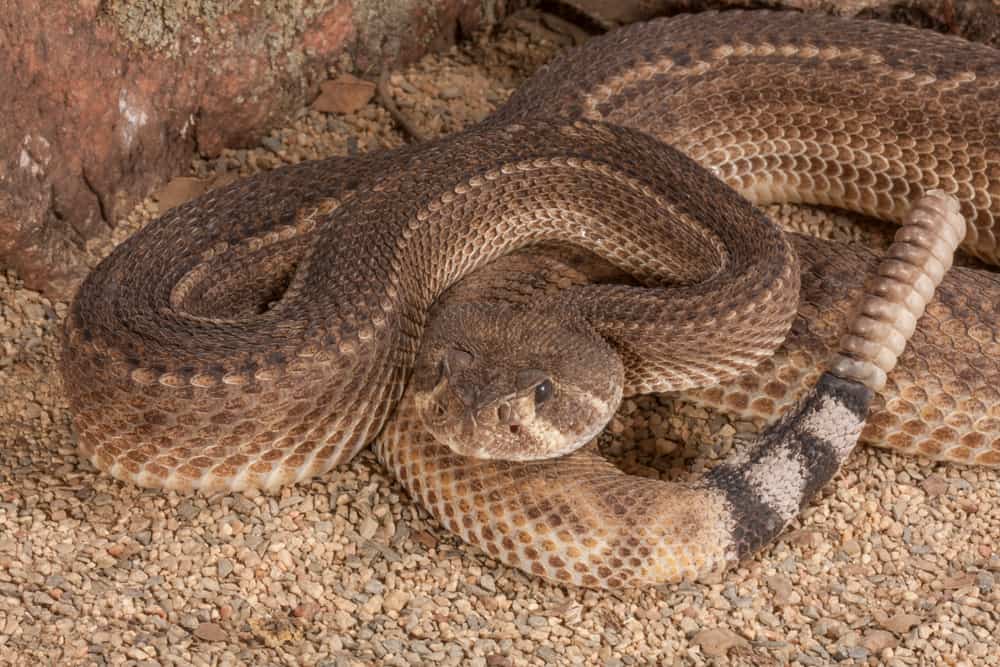
This venomous Viperid is in the southwestern US and Mexico. It is liable for most snakebite deaths in northern Mexico. Currently, there are no acknowledged subspecies. The Crotalus Atrox isn’t endangered.
The Western Diamondback resides in areas that range from below sea level to elevated to 6,500 feet above sea level; this is important as snakes are ectothermic (cold-blooded).
Ectotherms can’t adjust their body temperature; they rely on their environment to have the energy to be active. Patterns of predictable behavior are designed on whether they are nocturnal or diurnal.
The Crotalus Atrox is mainly diurnal during the spring seasons and nocturnal, surfacing in twilight and dusk hours in the summer months.
Adults commonly grow to 4 feet; males are significantly bigger than females. It’s the second most sizeable Rattlesnake in the US behind its cousins, the Eastern Diamondback.
The Crotalus Atrox is rare because it is a scavenger; it can also go two years in the wild without food. They ambush a variety of prey at night or early morning. Their target ranges from mammals to insects, birds and bugs. It enacts a key role in ecological systems.
Crotalus Cerastes (The Sidewinder / Horned Rattlesnake)
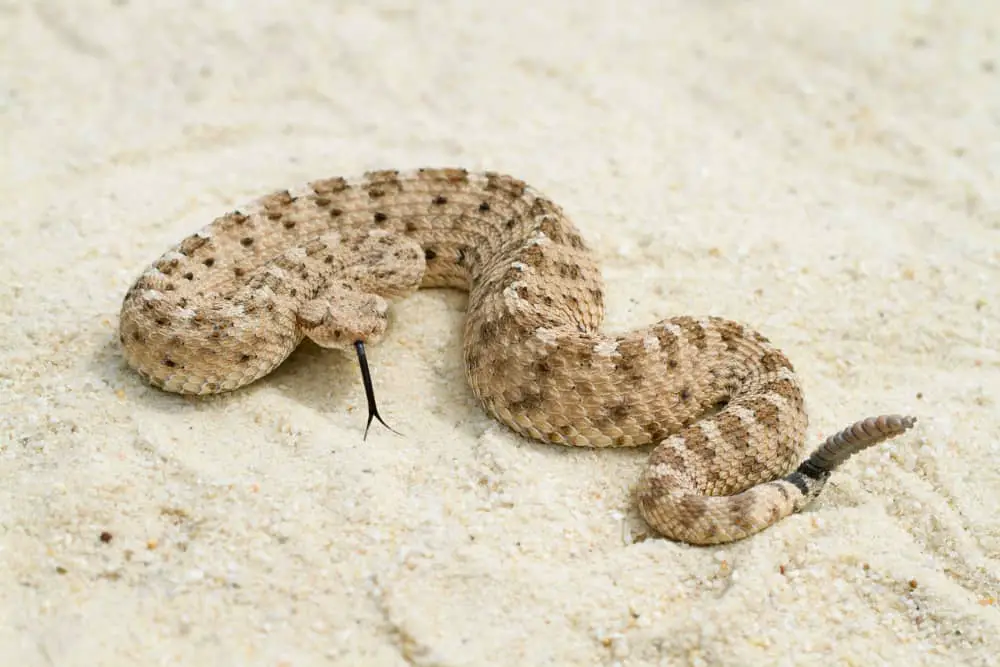
This snake is in the desert areas of the US, and the Sidewinder has evolved extraordinary skills to enable it to survive within this harsh terrain. There are three acknowledged subspecies.
The Horned Rattlesnake possesses a small stature, with adults growing 17 to 30 inches long. Females have more bodyweight and length than males; this is rare.
The Horned Rattlesnake derives its name from a single supraorbital spine on the eyebrow area of their face. The spine is an extension of the numerous carinated scales characteristic of the Viperidae family.
The function of the horn or spine is to shelter the eye from the desert sun and prevent sand particles from damaging the eye.
The Horned Rattlesnake also has the colloquial name- Sidewinder. Sidewinder refers to its peculiar and distinct movement of sidewinding in rapid s-shape motion across desert dunes. The sidewinding propulsion assists the serpent by using traction over sand.
This species is nocturnal over the hotter seasons and diurnal during the milder parts of the year.
Although the snakes are venomous, their venom constitution is weaker than other Rattlesnakes. They also possess minor-sized venom glands; they are still fatal, and direct medical attention is needed if bitten.
Crotalus Durissus (South American Rattlesnake)
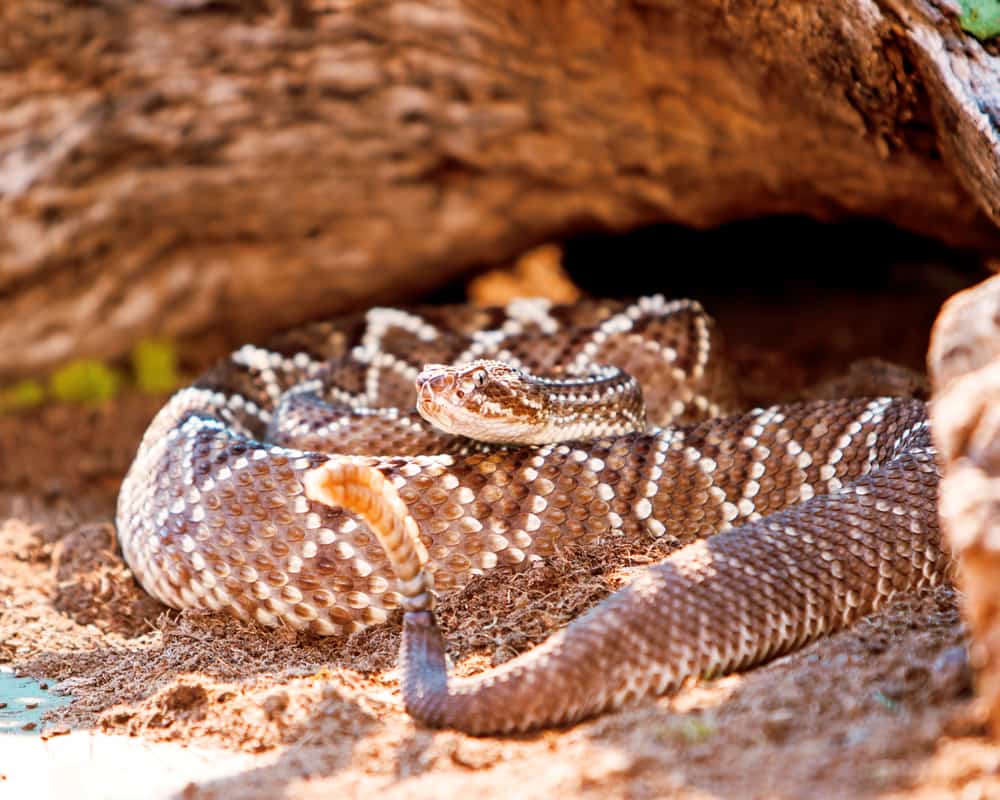
The South American Rattlesnake is a dangerously venomous Viperid in South America; it is extensively dispersed throughout the continent. Currently, there are several acknowledged subspecies.
It is considerable in size and length; it can reach anywhere from 4.9 feet to 6.2 feet. The South American Rattlesnake is recognized by two separate lines that begin at the seat of the head.
The temperament of this species is generally calm but will strike if provoked. This serpent surfaces at dusk and early morning.
The South American Rattlesnakes are more desirable in the savannah and semi-arid areas. It doesn’t live in the Andes Mountains but through different isolated locales across South America.
Crotalus Horridus (The Timber Rattlesnake)
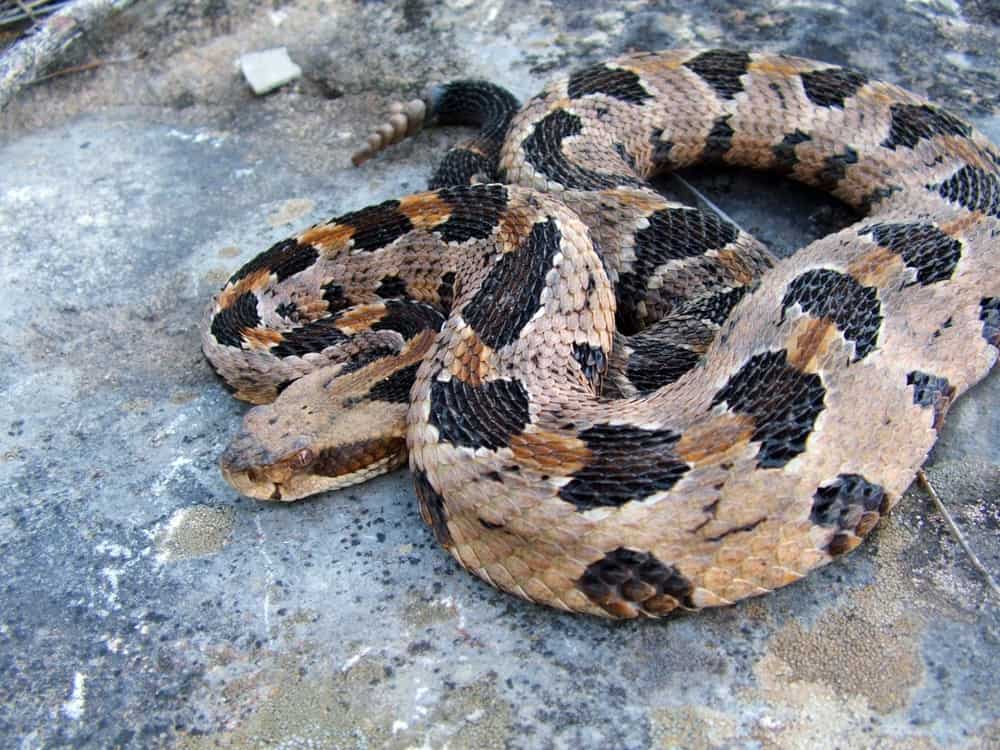
This Viperid of the Crotalinae subdivision is commonly referred to as the Timber Rattlesnake; it is endemic to eastern areas of the US. They are prolific in the US, second to the Prairie Rattlesnake.
Crotalus Viridis (Prairie Rattlesnake)
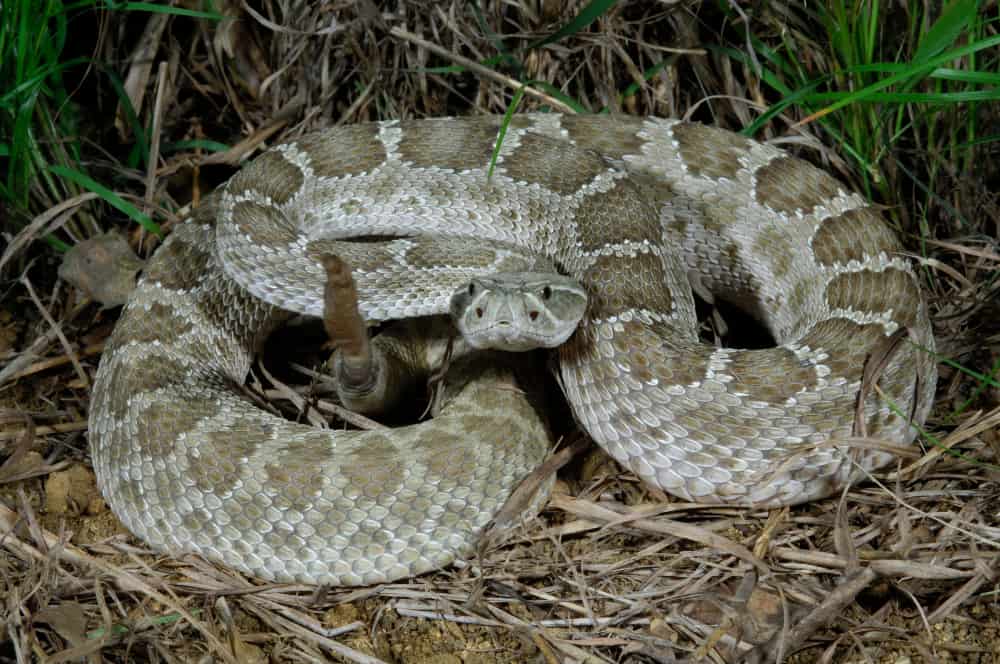
This Crotalinae Viperidae is a venomous species indigenous to the western US, northern Mexico, southwestern Canada; its colloquial name is the Prairie Rattlesnake or the Great Plains Rattlesnake.
Prairie Rattlesnakes are mainly terrestrial; however, they have been known to climb trees. They are diurnal during mild temperatures and nocturnal over the hotter months.
Sistrurus
Sistrurus are Viperids that belong to the subdivision Crotalinae of the Viperidae family. Their name has its roots in Latinized Greek Seistrouros (tail rattler) and shares its etymology with Egyptian sistrum, a rattle.
It is like rattlesnakes of the genus Crotalus in that both Viperids rattle their tails in a threat stance to warn and intimidate other species. However, it is unique to Crotalus Rattlesnake because they are smaller in size, and the scalation on their head is different.
Like the Agkistrodon Viperid, the Sistrurus Rattlesnake has nine large plates covering the surface of their heads. The Crotalus and almost all other Viperid species have lots of small scales protecting their cranium.
The Sistrurus rattle is also smaller than the sister species Crotalus. The rattle of the Sistrurus generates more of a high pitch, whirring noise. The Sistrurus possess a lower venom yield and are considered less threatening; however, every bite must be treated seriously, and immediate medical attention must be taken.
There are three recognized species of the Sistrurus: Sistrurus Miliarius, Sistrurus Catenatus, and Sistrurus Tergeminus.
Sistrurus Miliarius (Pygmy Rattlesnake)
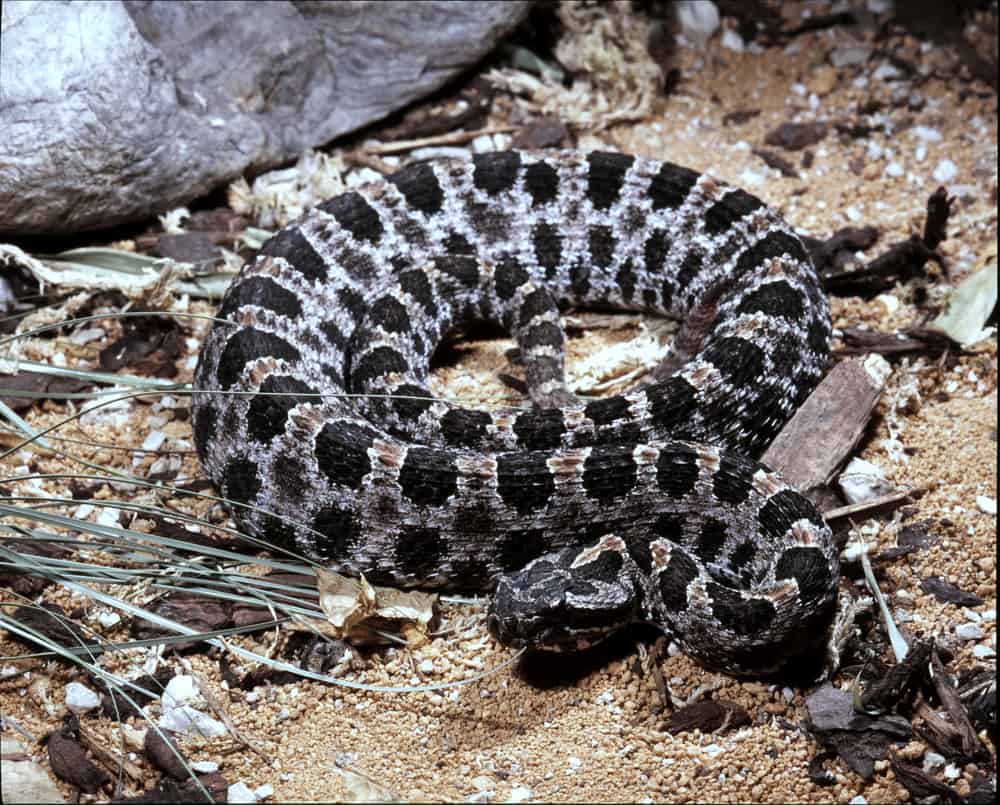
The Sistrurus Miliarius is commonly referred to as the Pygmy Rattlesnake. The Pygmy Rattlesnake is endemic to Southeastern America. There are three subspecies currently acknowledged.
The Pygmy Rattlesnake is small in stature; as an adult, it grows up to 16-24 inches in total length (tail included). In the center of its body, the arrangement of dorsal scales typically consists of 23. The dorsal designs comprise a succession of elliptical patches with moderately regular edges.
The Sistrurus Miliarius reside close to water like swamps, creeks, flood plains, and marshes, in flat woods, pine and scrub oak sandhills, coastal plains, and intermingled forests of pine and hardwood.
The Pygmy Rattler displays an array of individual behaviors and temperaments; some are hostile while others appear listless. They don’t burrow their underground tunnels; instead, they raid and live in the underground network dug by small rodents, gophers, and underground squirrels.
Sistrurus Catenatus (Massasauga)
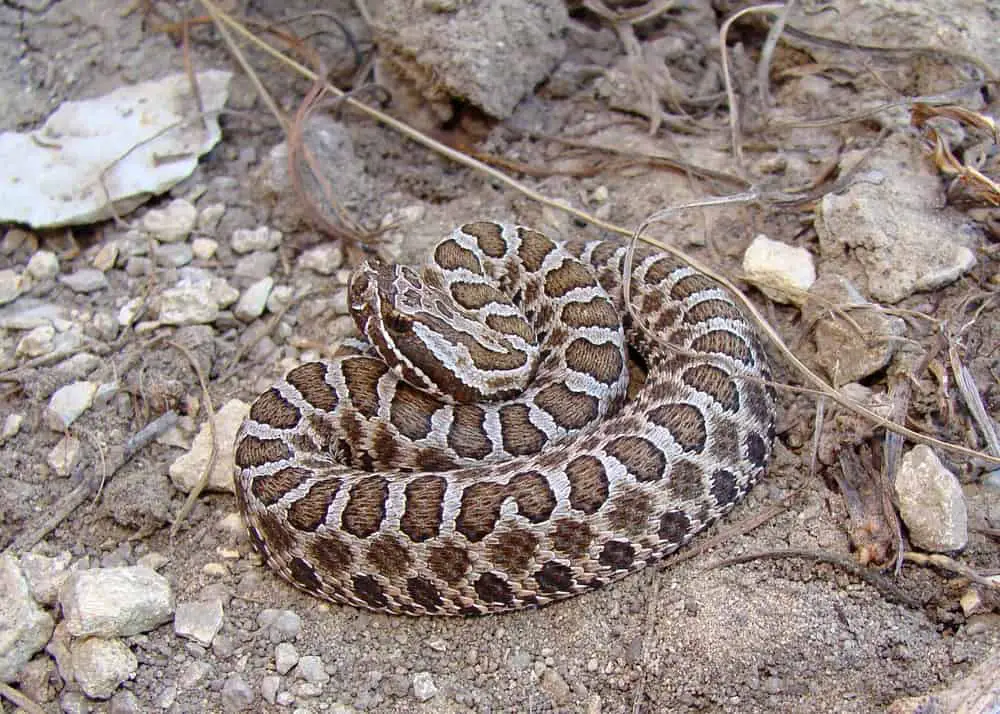
The Massasauga is endemic to parts of the Americas, from southern Ontario in Canada to northern Mexico and in midwestern North America. Like all Viperids, they are venomous. There are three recognized subspecies to this genus.
The Massasauga is moderate in size; as adults, they are 24-30 inches long. Its coloring is grey or tan with a rank of large circular black patches down the center of its back and alternating rows of black spots at its side. There are also recorded instances of melanistic or solid black Massasauga.
The Massasauga diet consists of an array of small vertebrates, including mammals (rodents), reptiles, frogs, salamanders, birds and other smaller snakes, and invertebrates like centipedes.
The Sistrurus Catenatus possesses a cytotoxic venom that annihilates tissue. Its venom also has specialized digestive enzymes that prevent blood clotting and hinder blood flow.
Following envenomation, prey with teeth or claws is already partially digested, enabling the Massasauga to relax and conserve energy before the feed. This energy conservation is characteristic of Rattlesnake’s excellent economy of motion.
The Massasauga is characteristically shy and circumvents contact with humans when possible. There are only two recorded instances of human fatality from Massasauga bites, both in Ontario and in both cases, proper treatment wasn’t received.
Sistrurus Tergeminus (Western Massasauga)
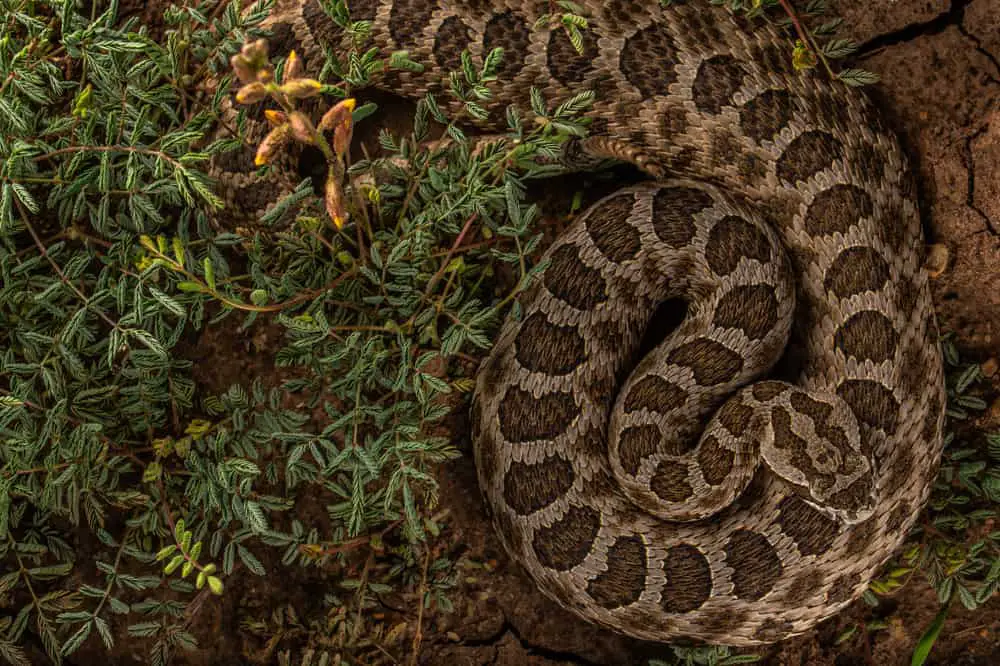
The Sistrurus Tergeminus, commonly called the Western Massasauga, is found in the Southwestern plains of the US. The adult size generally measures 14-36 inches long.
The coloring of the Western Massasauga is light grey and tan with dark or black patches of circular markings down its back. It’s like Sistrurus Catenatus but lighter.
They reside in grassland habitats, on the periphery of open woodlands or rock-strewn hillsides and frequently, they dwell in tunnels dug by rodents. Their rattles resonate at higher frequencies than other Rattlesnakes giving them the nickname buzz tail.
They are mainly nocturnal, particularly during the summer season when the heat hinders their activity. They usually surface directly after rainstorms.
Conclusion
Rattlesnakes are a unique species distinguished by their tail-end keratinous interlinking empty shells that create a whizzing sound when the serpent is in a threat stance. The Rattlesnakes belong to two distinct species- the Crotalus and Sistrurus of the Crotalinae (Pit Viper) subdivision of the Viperidae family (Viper).
The Sistrurus is unique to the Crotalus in their heads are covered in nine broad plates, while the Crotalus’ head is covered in numerous small scales. The Sistrurus also has a slight rattle that creates a high pitches buzz significantly softer than Crotalus. There are 36 genera of Rattlesnakes, and there are 60-75 subdivisions.
References:
California Herps: Rattlesnakes
NWF: Rattlesnakes
Britannica: Rattlesnake
New World Encyclopedia: Rattlesnake
Live Science: Rattlesnakes
Zoo Keys: Rattlesnake
San Diego Zoo: Rattlesnake
SREL Herp: Sismil
Agrilife: Rattlesnakes
Desert USA: Rattlesnakes
Frontier Sin: Crotalus Durissus Ruruima
Science Direct: Crotalus Durissus Terrificus
Animal Diversity: Crotalus Horridus
Science Direct: Crotalus Genetics
Science Direct: Crotalus Immunology
Britannica: Crotalus
Canada: Prairie Rattlesnake
National Geographic Kids: Rattlesnakes
Desert Museum: Rattlesnakes
Digital Atlas: Crotalus Viridis
Florida Museum: Cottonmouth and Diamondback Rattlesnake
SD Parks: Rattlesnakes
Smithsonian Magazine: Rattlesnakes Trick Human Thinking They’re Close
BBC: Science Environment
STL Zoo: Timber Rattlesnakes
Live Science: Vipers
Science Direct: Sistrurus
Animal Diversity: Sistrurus Miliarus
Reptile Database: Tergeminus
SREL Herp: Sismil
Bioweb: How do Massasauga get Nutrient
Kansas Herp Atlas: Western Massasauga
Cedars Sinai: Endothilial Function Testing



